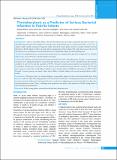Please use this identifier to cite or link to this item:
https://hdl.handle.net/20.500.14356/1478Full metadata record
| DC Field | Value | Language |
|---|---|---|
| dc.contributor.author | Mishra, Deepak | - |
| dc.contributor.author | Das, Amit Kumar | - |
| dc.contributor.author | Chapagain, Ram Hari | - |
| dc.contributor.author | Jha, Nitu Kumari | - |
| dc.contributor.author | Rai, Ganesh Kumar | - |
| dc.date.accessioned | 2023-05-14T07:52:40Z | - |
| dc.date.available | 2023-05-14T07:52:40Z | - |
| dc.date.issued | 2018 | - |
| dc.identifier.citation | MishraD., DasA. K., ChapagainR. H., JhaN. K., & RaiG. K. (2019). Thrombocytosis as a Predictor of Serious Bacterial Infection in Febrile Infants. Journal of Nepal Health Research Council, 16(41), 401-404. https://doi.org/10.33314/jnhrc.v16i41.1673 | en_US |
| dc.identifier.issn | Print ISSN: 1727-5482; Online ISSN: 1999-6217 | - |
| dc.identifier.uri | http://103.69.126.140:8080/handle/20.500.14356/1478 | - |
| dc.description | Original Article | en_US |
| dc.description.abstract | Abstract Background: Most of the febrile infants <90 days old will have no more than a mild viral infection but there is a substantial minority that will be diagnosed as having serious bacterial infection at a reported prevalence of 10–14%. A simple, readily available, inexpensive diagnostic marker that yields results quickly and also accurately identifies bacterial infections in febrile infants would be of great value in management of these infants. This study aims to assess the role of thrombocytosis in predicting serious bacterial infection in young febrile infants beyond neonatal period. Methods: A hospital based cross-sectional observational study was conducted from May 2016 to April 2017 on 76 febrile infants of age group 29-90 days in Kanti Children’s Hospital. Results: The incidence of serious bacterial infection was found 43 (56.6%). Thrombocytosis, elevated C-reactive protein and pyuria were significantly higher in serious bacterial infection cases (p value <0.05). Thrombocytosis alone had the sensitivity of only 53.5%, but had specificity of 90.9%. Elevated C-reactive protein had the best sensitivity (81.4%). Combination of leukocytosis, elevated C-reactive protein, pyuria and thrombocytosis had better sensitivity (93.0%) than these parameters alone. The overall ability of platelet count to identify infants with SBI was only moderate (AUC: 0.722). Elevated C-reactive protein was found to have better ability to identify infants with serious bacterial infection (AUC: 0.846). Conclusions: Thrombocytosis is a common finding in young infants diagnosed with serious bacterial infection. It has however, moderate ability in identifying infants with serious bacterial infection. Combining thrombocytosis with elevated C-reactive protein, leukocytosis and pyuria has better sensitivity in diagnosing serious bacterial infection than these individual parameters alone. Hence, combining these parameters may help in early prediction of febrile young infants at risk of serious bacterial infection. Keywords: Febrile young infants; serious bacterial infection; thrombocytosis. | en_US |
| dc.language.iso | en | en_US |
| dc.publisher | Nepal Health Research Council | en_US |
| dc.relation.ispartofseries | Oct-Dec 2018;1673 | - |
| dc.subject | Febrile young infants | en_US |
| dc.subject | Serious bacterial infection | en_US |
| dc.subject | Thrombocytosis | en_US |
| dc.title | Thrombocytosis as a Predictor of Serious Bacterial Infection in Febrile Infants | en_US |
| dc.type | Journal Article | en_US |
| local.journal.category | Original Article | - |
| Appears in Collections: | Vol. 16 No. 4 Issue 41 Oct - Dec 2018 | |
Files in This Item:
| File | Description | Size | Format | |
|---|---|---|---|---|
| 1673-Manuscript-7822-3-10-20190221.pdf | Fulltext Article. | 221.47 kB | Adobe PDF |  View/Open |
Items in DSpace are protected by copyright, with all rights reserved, unless otherwise indicated.
